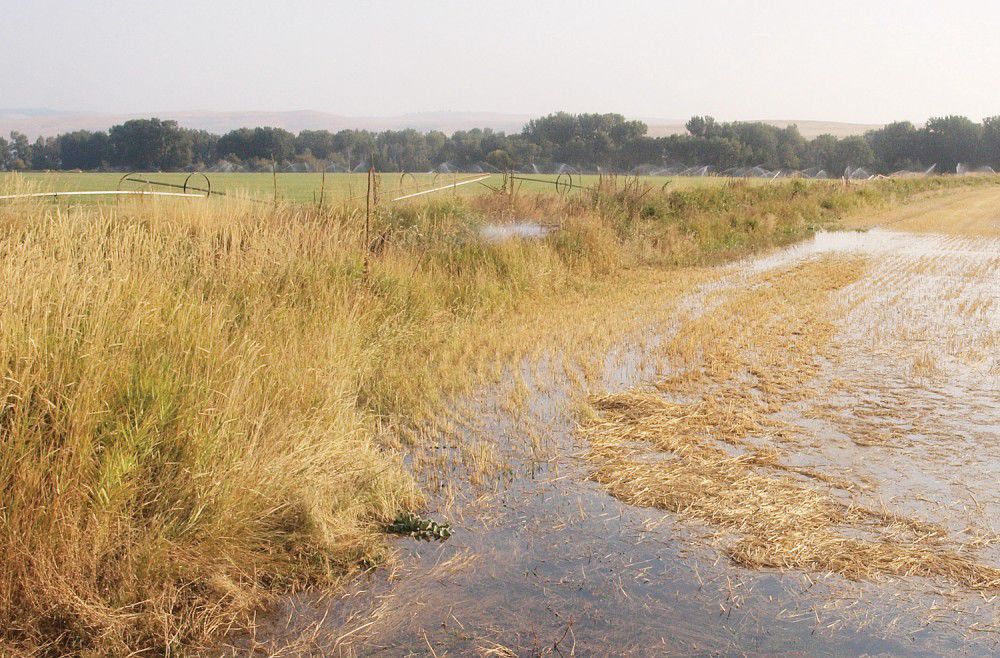Energy costs partially offset weather gain for crops
Published 5:00 pm Tuesday, September 25, 2012

- <p>Following rainfall last weekend that briefly provided respite from a lengthy dry spell, local grain and hay growers continued to add water to grain and hay crops Tuesday morning. In the foreground is flood irrigation with wheel lines adding water coverage in the distance.</p>
The long stretch of sunny days in Wallowa County may look to be a panacea for local grain and hay growers, but farmers in the know are quick to point out how added costs to irrigate fields counters some monetary gains from any additional crop growth.
Tim Melville, an Enterprise farmer who teams with son Kurt to work 1,500 acres of grain under the name Cornerstone Farms Joint Venture, says between added electricity and labor costs their farms expenses this summer are elevated about $21 to $23 per acre above normal.
Cornerstone Farms sells and trucks about 75 percent of its harvested grain to about a half dozen buyers within the Pendleton, Spokane, and Grangeville, Idaho, triangle, and sells the remainder of its crop to a 43-grower, 10-year-old entity named Shepherds Grain thats based in Ritzville, Wash.
Melville says Shepherds Grain growers meet annually to compute production costs, figure in a profit margin, and establish prices Shepherds Grain will pay member growers per bushel for the upcoming year.
Because of Shepherds Grains positive reputation, says Melville, grain sold to that entity normally results in higher monetary returns than on the commodity market, from which the price of most Cornerstone Farms grain prices are computed.
And yet thats not the case in 2012, he says, because a drought in the Midwest has bumped commodity market prices, placing them almost on a par this summer with prices of grain sold to Shepherds Grain.
Melville speaks about the commodities markets innate whims. If everybody has a good year we all suffer because the price goes down, he says.
According to Enterprise-based Oregon State University Extension agent John Williams, a great source of information about local grain and hay growers is the Wallowa County Hay Growers Associations website. The association boasts 25 member-farms with seven entities such as the local extension office and the Wallowa County Grain Growers listed as associate members.
The only president the local hay growers group has had in its seven years of existence is farmer Mark Butterfield, of Joseph. Butterfield and wife Anna own B & B Hay Inc.
Butterfield declined to say how many acres of land he hays, but did say about two-thirds of his crop is timothy hay and one-third alfalfa hay.
He said, overall, that his tonnage is down slightly this year, explaining that his hay crops are so dry that its hard to cover all of his acreage with water.
Butterfield says timothy hay and alfalfa hay are different crops totally, and as such require individualized types of treatment.
He says timothy hay, because its an export crop, regularly is worked and harvested in the heat of the day to reduce the amount of moisture content in the final crop. Because ship containers sent overseas to such ports as Japan, United Arab Emirates, Korea, and China are sealed, spoilage would occur if significant amounts of moisture were present.
Jim Petty, who since has moved to Madras, and Dan Gover, who with wife Joyce owns Gover Ranch, of Enterprise, were pioneers in introducing the hay export trade to Wallowa County.
According to Williams, Petty and Gover traveled overseas in the late 1980s and/or early 1990s to create a market where none previously existed.
One key to early negotiations with other nations, says Williams, was learning exactly what rules applied to imported hay in different countries, and then learning to farm crops to meet such standards.
Butterfield now speaks of Pettys early operations here in these words: We watched across the fence and thought he was crazy for a lot of years and now were all doing what he does.
Butterfield says Wallowa County was the first Oregon county to come up with a certified hay program.
The process of certifying hay in Wallowa County, done to document quality, does not come without price to those who choose to use it.
One of two trained crop inspectors provided by Wallowa County either Allen Schnitzky or Carl McFetridge will walk fields prior to harvest to determine weed content in the crop.
Those inspections cost the hay grower $3 per acre and, if the field passes inspection, hay from that field will be certified as either Wallowa County Premium Grade or Reclamation Grade, which is slightly lower.
Butterfield says both grades granted within the county are higher than the national standard of weed-free hay as established by the North American Weed Management Association (NAWMA).
The large 3×4-foot bales produced at B & B Hay Inc. regularly weigh between 1,100 and 1,400 pounds, says Mark Butterfield.
Williams says varieties of hay raised in Wallowa County include alfalfa, timothy, grass, orchard, and clover. By his calculations, about 130,000 tons of hay was raised locally in 2011 and about 60,000 tons of that total was consumed locally. The remainder was trucked out of the county with some of it earmarked for overseas ports. A common launching point for such overseas trade is at Boardman.









